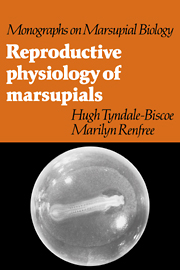Book contents
- Frontmatter
- Contents
- Preface
- 1 Historical introduction
- 2 Breeding biology of marsupials by family
- 3 Sexual differentiation and development
- 4 Male anatomy and spermatogenesis
- 5 The female urogenital tract and oogenesis
- 6 Ovarian function and control
- 7 Pregnancy and parturition
- 8 Lactation
- 9 Neuroendocrine control of seasonal breeding
- 10 Marsupials and the evolution of mammalian reproduction
- References
- Index
7 - Pregnancy and parturition
Published online by Cambridge University Press: 06 January 2010
- Frontmatter
- Contents
- Preface
- 1 Historical introduction
- 2 Breeding biology of marsupials by family
- 3 Sexual differentiation and development
- 4 Male anatomy and spermatogenesis
- 5 The female urogenital tract and oogenesis
- 6 Ovarian function and control
- 7 Pregnancy and parturition
- 8 Lactation
- 9 Neuroendocrine control of seasonal breeding
- 10 Marsupials and the evolution of mammalian reproduction
- References
- Index
Summary
Marsupials give birth to small altricial young after a gestation period which lasts only 12–38 days (Table 2.2). The young then spends a much longer period within a pouch or nest nurtured by milk while it completes its growth and development to the stage of independence at weaning. In recent years there has been much written about the relative merits of marsupial reproduction compared to eutherian reproduction (Lillegraven 1969; 1975; 1979; Sharman, 1970; Cox, 1977; Kirsch, 19776; Renfree, 1981b; Padykula & Taylor, 1982). We will enter this debate in Chapter 10 but here we attempt to present a straightforward account of pregnancy and parturition in marsupials uncluttered, so far as possible, by preconceived notions of evolutionary relationships. The process from ovulation to parturition in marsupials can be divided into 10 fairly discrete stages, which are described below.
Sperm transport and fertilisation
Development of the spermatozoa and their maturation in the epididymis have been discussed in Chapter 4 and the varieties of courtship and copulatory behaviour in the several orders of marsupials was considered in Chapter 2. The fate of the spermatozoa after their deposition in the female genital tract and the process of fertilisation itself are less well known. There is a number of isolated observations on different aspects of the phenomena in many species but there are detailed, timed observations on only three species, Didelphis virginiana (Rodger & Bedford, 1982a,b), Macropus eugenii (Tyndale-Biscoe & Rodger, 1978) and Antechinus stuartii (Selwood, 1982b) (Fig. 7.1).
- Type
- Chapter
- Information
- Reproductive Physiology of Marsupials , pp. 258 - 342Publisher: Cambridge University PressPrint publication year: 1987



